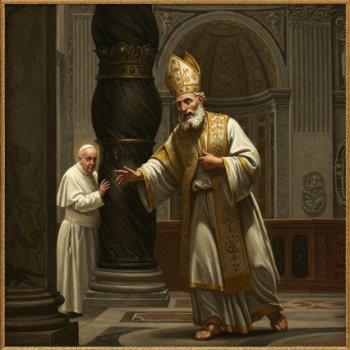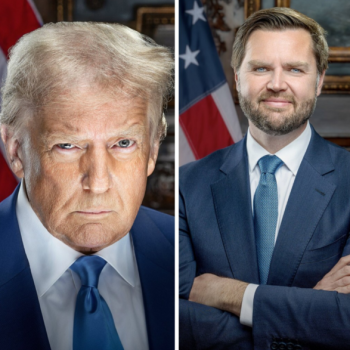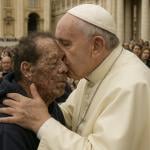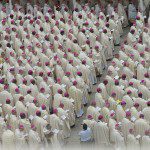More than once in the last couple of years others have continued criticism and even insisted that I apologize for being in favor of the Iraq War in 2003. There are very strong moral reasons why the United States went into Iraq in 2003, and why it was strategically sound to do so (despite the wise caveats of many experienced leaders, most notably Pope John Paul II). Because the pope had publicly described me as one of his half dozen lay friends around the world, and because I loved him, it was exceedingly difficult, and painful, for me to put our friendship at risk.
As I said many times in those days, I was glad our pope opposed even the hint of a Muslim-Christian religious war. I was also glad our president recognized the moral and strategic duty to halt Saddam Hussein’s many violations of the peace treaty he signed in 1991.
In 1990, after Saddam Hussein boastfully and violently invaded Kuwait, a coalition of thirty-nine nations formed to remove Saddam’s forces from that small country.
That phase of the war ended swiftly in early 1991. U.N. Security Council Resolutions obliged Iraq to meet certain stringent conditions, including providing a list of all locations where it housed chemical weapons and allowing U.N. inspections of those sites, as well as the establishment of no-fly zones over certain Shiite parts of southern Iraq and the Kurdish zone in the north.
Over the next ten years, alas, Saddam Hussein’s violations of the truce escalated. The U.N. continued issuing formal resolutions warning him to stop. Saddam thought these threats meaningless and pressed on.
An inventory of Saddam’s weapons was prepared, and he was obliged to keep records as he destroyed them. U.N. inspectors began discovering, however, that stores of botulin, sarin, anthrax, and mustard gas had disappeared. As U.N. Chief Weapons Inspector Hans Blix told The New York Times in November 2002, “The production of mustard gas is not like the production of marmalade. You’re supposed to keep some track of what you produce.” There was no reliable account of what was where, and no satisfactory documentation of the weapons’ destruction was submitted.
Then on September 11, 2001, nineteen Middle Eastern terrorists hijacked four airplanes, their tanks full for transcontinental flights, departing from three major U.S. cities. As we and our friends all watched in horror, the first plane crashed into the North Tower of the World Trade Center, and then the second into the South Tower, with fuel tanks exploding on impact into huge, orange fireballs. The towers collapsed, floor by floor, with office workers and many brave firemen inside.
Once again, a large international coalition formed, this time to shut down the campsites in Afghanistan where legions of future terrorists were training. Most of Afghanistan was liberated quickly. The cruel and violent Taliban were driven into the southern Himalayas. Al-Qaeda leader Osama bin Laden fled with them.
Bin Laden disappeared into the mountains, but with the more habitable parts of Afghanistan liberated, the bulk of the American forces was about ready to leave. Meanwhile, video began emerging from Iraq, showing not only the use of chemical weapons on Shiite villages in the south, but also various poisonous gasses used on animals for experimental purposes.
When I was in Rome in early 2003, Italian military intelligence briefed me on weapons of mass destruction (WMDs) being prepared in Iraq. Everyone already knew of short-range missiles aimed at Israel, so I assumed the WMDs consisted of the arsenal of chemical weapons inventoried after the war of 1991.
During the Clinton administration, we learned of expanding new capacities and methods for terrorists to commit mass destruction using chemical and other biological agents. Defense Secretary Cohen warned of the possible deadly release of small but potent amounts of chemicals in public transportation systems. And after September 11, 2001, no U.S. president could ignore Saddam Hussein’s apparent interest in such weapons. The man sworn to protect and defend the United States had to confront an ugly fact: another attack on U.S. soil, executed by lone operators in one or more American cities at the same time, was not impossible.
Should the president imagine the likelihood as closer to 100 percent, or closer to 0 percent? Either way, no president could avoid a decision. Having experienced Saddam Hussein’s megalomania in Kuwait, and again in his repeated use of chemicals against Shiite villages in his own country and flagrant defiances of the U.N., how would you assign the probabilities? In my judgment, then as now, any president who did not act against Saddam Hussein would be held responsible for any further destruction in the U.S. by Middle Eastern terrorists.
But there are still deeper reasons why it was right and good for the allied coalition to liberate Iraq in 2003. We will review these in part two, to come.















